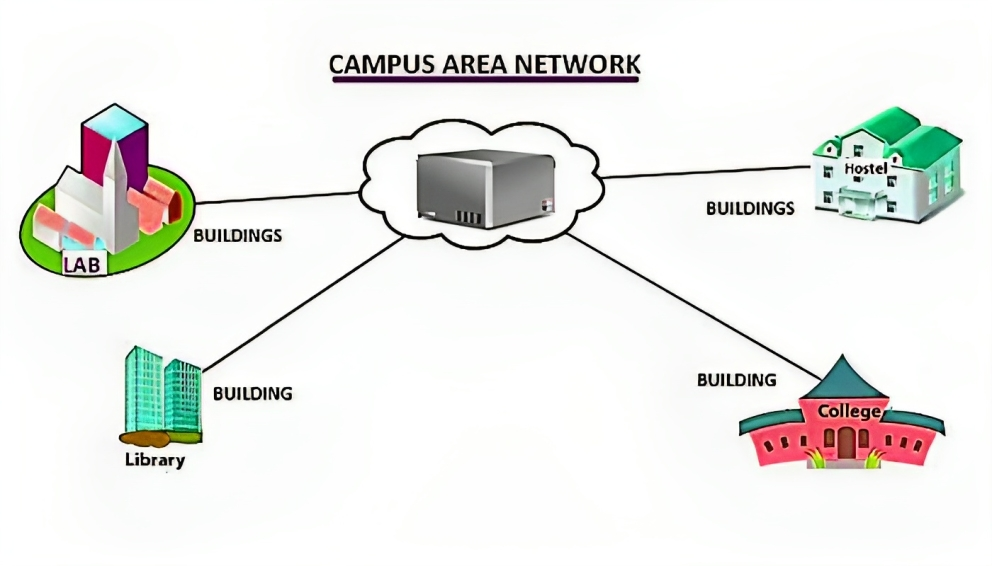📡 Campus Area Network (CAN): Benefits, Examples & Diagram
In today’s digitally connected world, efficient networking infrastructure is crucial for organizations, universities, and large business campuses. One of the most effective solutions is the Campus Area Network (CAN). If you’re searching for “Campus Area Network advantages and disadvantages” or wondering about its real-world applications, this guide will provide an in-depth analysis.
Whether you’re an IT professional, a student, or a tech enthusiast, this article covers CAN’s advantages, limitations, examples, range, and comparisons with other networks like LAN and MAN.
ad

🔗 What is a Campus Area Network (CAN)?
A Campus Area Network (CAN) is a network infrastructure designed to connect multiple Local Area Networks (LANs) within a specific geographic area, such as:
- University Campuses 🎓
- Corporate Buildings 🏢
- Military Bases 🌟
- Industrial Complexes 🏭️
ad
Unlike a Metropolitan Area Network (MAN), which covers an entire city, a CAN is limited to a smaller, controlled space. The Campus Area Network range typically extends over 1 to 5 kilometers, depending on its infrastructure and fiber optic implementation.
📊 Key Differences: CAN vs. LAN vs. MAN
| 🔍 Feature | 🏫 Campus Area Network (CAN) | 🏠 Local Area Network (LAN) | 🌆 Metropolitan Area Network (MAN) |
|---|---|---|---|
| 🌍 Coverage Area | University, office complex, or military base | A single building or floor | Entire city or metropolitan region |
| ⚡ Speed & Performance | 🚀 High-speed, reliable connectivity | ⚡ Extremely fast but limited in range | 🏎️ Slower than CAN due to greater distance |
| 🔐 Security | 🛡️ Enhanced control and monitoring | 🔒 Strong but confined to a small space | 🔓 Requires robust security due to larger exposure |
| 💰 Infrastructure Cost | 💵 Moderate to high | 🏷️ Low | 💲 High due to broader coverage |
By understanding these differences, organizations can determine the most suitable network solution for their needs.
✔️ Advantages of Campus Area Networks
- High-Speed Connectivity: Faster data transmission compared to WANs or MANs due to their localized nature.
- Enhanced Security: Centralized network management enables better security control and threat detection.
- Efficient Resource Sharing: Multiple buildings can share resources like printers, databases, and storage servers.
- Reduced Latency: Low-latency connectivity is essential for high-speed data applications, including research and cloud computing.
- Cost-Effective: Compared to WANs, CANs reduce operational costs while ensuring efficient network performance.
❌ Disadvantages of Campus Area Networks
- Limited Geographical Range: A CAN’s range is confined to a campus or industrial complex, making it unsuitable for city-wide connections.
- Infrastructure Costs: Requires routers, fiber optics, and maintenance, which can be expensive initially.
- Potential Security Risks: If not properly managed, unauthorized access or cyber threats can compromise the entire network.
🔄 Campus Area Network Examples
- University Campuses: A large university network connecting libraries, research centers, and dormitories.
- Corporate Campuses: A multinational office complex using a CAN to link multiple departments.
- Smart Hospitals: Large medical institutions that integrate CAN to connect patient records, diagnostic labs, and monitoring systems.
- Military Bases: Secure and encrypted communication channels for defense facilities.
🌐 Campus Area Network Diagram
[Building A]----[Main Server]----[Building B]
| |
[WiFi Access] [Data Center]
| |
[Building C]----[Control Center]This Campus Area Network diagram represents how multiple buildings connect through a centralized infrastructure, ensuring high-speed and reliable data transmission.
👨💻 Use of Private 5G in CANs
With 5G networks emerging, private 5G integration in CANs offers:
- Ultra-fast connectivity
- Low-latency performance
- Greater bandwidth for IoT devices
🔎 Example: Universities utilizing 5G-powered CANs for real-time virtual reality (VR) learning and remote lab simulations.
❓ Frequently Asked Questions (FAQs)
1. What is the main purpose of a Campus Area Network?
A Campus Area Network provides high-speed, secure, and localized connectivity between multiple buildings within a university, corporate, or military environment.
2. What are the main advantages of a Campus Area Network?
The advantages of a Campus Area Network include better security, improved speed, centralized control, and cost efficiency.
3. How does a CAN differ from a LAN and MAN?
A LAN covers a single building, a MAN covers an entire city, while a CAN is designed for medium-sized areas like corporate campuses or universities.
4. What is an example of a Campus Area Network?
A university campus that links classrooms, libraries, and research facilities using a centralized fiber-optic network is an example of a CAN.
5. What is the range of a Campus Area Network?
The Campus Area Network range is typically 1 to 5 kilometers, depending on the infrastructure and cabling used.
📝 Conclusion
A Campus Area Network (CAN) is an indispensable networking solution for large-scale institutions like universities, hospitals, and corporate campuses. Offering high-speed connectivity, enhanced security, and centralized control, CANs play a crucial role in modern digital infrastructure.
With technological advancements like private 5G integration, the future of CANs will be even more robust, ensuring seamless connectivity in an era where digital transformation is essential.
By leveraging Campus Area Network advantages, organizations can streamline operations, boost security, and enhance efficiency, making it a preferred networking solution for controlled environments.
ad


Comments are closed.